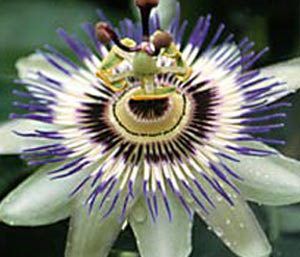Passion flower (passion vine) is found in every country except Europe, Africa and Antarctica. There are over 500 known species of passion flower and they are almost always vines. Some of the species grow as shrubs but they are few and far between. The passion flower plant bears an edible fruit called passion fruit.
The name “Passion Flower” has given rise to many names which relate it to sex or romance. However, the name does not relate to these things at all. The word passion actually refers to the passion of Jesus Christ. The structure of the plant itself was used to symbolize the last days of Jesus Christ and the Crucifixion. This all happened during the 15th and 16th centuries.
Most passion flower plants require pollination by large bees, hummingbirds, bats or wasps. A few of them pollinate themselves. The pollen in the passion flower is a very important source of food for a large number of insects. An interesting feature of some of the passion flower plants keep butterflies from laying too many eggs on them. They actually have small nubs on them that look like butterfly eggs. This tricks the butterfly into believing there are more eggs on the plant than there actually are.
Passion fruit is harvested in great numbers from south Florida and the Caribbean. Two types of fruit are traded under the same name. One is small and purple while the other is large and yellowish to orangish in color. This fruit is almost exclusively used to make juice.
Roots and leaves of the passion flower species, Maypop, were used by Native Americans and later on the colonists began using them as well. The leaves were used fresh or dried out to make a tea that was useful in treating epilepsy, hysteria and insomnia. This tincture even had properties that helped to soothe pain.
Several different species of passion flower have been found to work well as an anti-depressant. The roots and leaves are the most potent source of the compounds used to treat depression. The fruit and flowers have very little of this substance in them. The leaves and roots have also been used to enhance the effects of recreational drugs. Dried leaves can be smoked to produce a rather nice effect.
There have been a lot of studies of the species Passiflora. These studies aimed to see how well the herbs performed at treating generalized anxiety disorder. The results showed that the extract worked just as well as oxazepam and had far fewer side effects. The medical field is working on long term studies right now.
Using Herbs to Calm Tension, Anxiety, Panic and Stress
PureCalm helps maintain balanced emotions during everyday pressure, stress and common nervous tension. Created by our team of experts in natural medicine, this remedy is pharmaceutically manufactured to the highest standards, combining the soothing properties of Lemon Balm with those of Lavender and Passion Flower, to bring you relief within minutes!
For those who suffer from chronic anxiety, PTSD and/or severe panic attacks, combine PureCalm with MindSoothe for effective long-term reduction of your symptoms.
Learn more about PureCalm now.
Why do we promote this?Save


 Fill out the form below to sign up to our free natural health and healing newsletter and stay up to date on our latest articles about holistic healing therapies and effective home remedies for common ailments. As a thank you for joining our newsletter, we’ll also send you
Fill out the form below to sign up to our free natural health and healing newsletter and stay up to date on our latest articles about holistic healing therapies and effective home remedies for common ailments. As a thank you for joining our newsletter, we’ll also send you
Thanks for sharing this great botanical with us. I had no idea it could be used as a depression remedy.